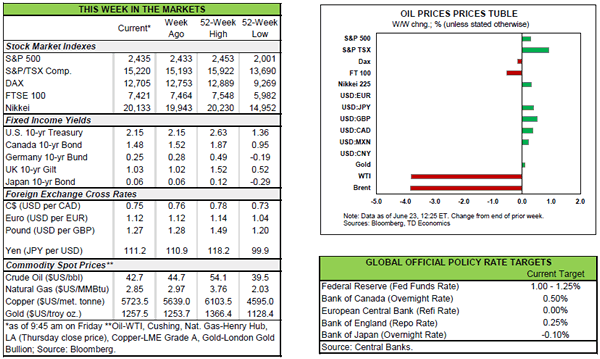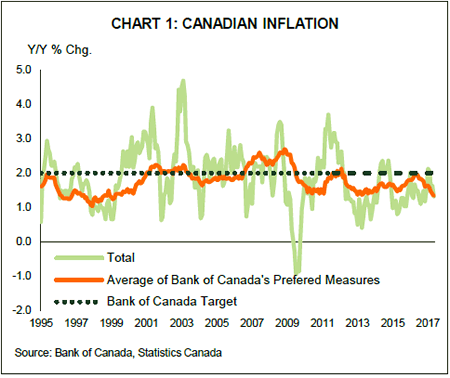HIGHLIGHTS OF THE WEEK
United States
- Equity markets started off the week on a positive note. But the advance proved transitory as oil prices slid into bear territory, sending energy stocks and the main indices lower.
- With little in the way of economic data, Fed speeches took center stage. While echoing support for last week’s decision, some Fed speakers appeared to take on a more dovish tone, with Harker and Evans putting an emphasis on waiting for further proof to hike again.
- The only significant economic data releases this week pertained to housing activity. Existing home sales surprised on the upside. Meanwhile,sales in the smaller and more volatile new home market, also rebounded in May.
Canada
- For those trying to time the next Bank of Canada rate, this week’s economic data brought mixed signals with inflation easing for a fifth straight month and momentum retail spending holding strong into the second quarter of the year.
- While soft inflation is likely to keep the Bank of Canada on hold through July, the pick-up in economic momentum offers good grounds for an October rate hike. Inflation is a lagging indicator, and May’s reading likely reflects soft economic conditions from late 2015 to early 2016. But inflation may be nearing a trough, as slack is being eaten up at a quickened pace.

UNITED STATES – FED SPEECHES TAKE CENTER STAGE
Markets started off the week on a positive note. Tech stocks bounced back on Monday as industry leaders met with President Trump at the first gathering of the American Technology Council. Meanwhile, financials were buoyed by comments from FOMC voting member Dudley that didn’t seem too concerned with the slowdown in inflation. Sentiment was also supported by Macron’s majority-win of the French parliamentary elections.
Unfortunately, the advance proved transitory. Oil prices slid into bear territory on account of rising production among the U.S., Libya and Nigeria and doubts as to whether recent OPEC cuts would be sufficient to manage the supply glut. This sent energy stocks and the main indices lower and enabled a move toward safe heaven assets (Chart 1).
With little in the way of economic data, Fed speeches took center stage. Given that last week’s decision to hike was not unanimous and the fact that inflation has drifted lower, FOMC members appeared to be on the defensive. Vice-Chair Fischer pointed to "high and rising" home prices as one of the hazards of keeping rates low for long. While echoing support for last week’s decision, other Fed speakers appeared to take on a more dovish tone, with Harker and Evans putting an emphasis on waiting for further proof to hike again. Bullard (non-voter) suggested that the expectation for rates rise to 3% over the next two and a half years is "unnecessarily aggressive."
Still, the Fed is sticking to its guns in expecting another rate hike by the end of this year, betting that the factors weighing on price growth will prove temporary and that a tight labor market will pull up wages and buoy inflation.
They may also get some help from a lower U.S. dollar, which is well off its peak level set earlier this year and is on track to end lower again the week. A lower dollar should help put upward pressure on goods prices, which have been consistently negative over the past year.
The only significant economic data releases this week pertained to housing activity. Existing home sales rose 1.1% m/m, surprising on the upside. Tight inventory levels and rising prices have weighed on momentum recently. But, declining mortgage rates contributed to the positive print and should provide further support in June, with the volume of mortgage applications on an upswing during the month. Sales in the smaller and more volatile new home market, also rebounded in May, with both series retaining an upward trajectory (Chart 2).
Rising interest rates, combined with robust price growth on the bigger resale segment are expected weigh on affordability. Still, households are likely to withstand the incremental increases in borrowing costs thanks to a solid labor market that is poised to deliver continued job and income gains. An improvement in the homeownership rate is also expected to provide a gentle tailwind as outlined in our recent report, with resales expected to advance by 3.4% this year and 2.6% in 2018 to nearly 5.8 million by the end of the forecast horizon. Price growth should remain strong this year, holding near 6%. But a rebound in for-sale inventory, which is expected to be more of a factor next year, will help keep price growth in check at around 4% in 2018.


CANADA – MIXED SIGNALS
Those trying to time the next Bank of Canada move received mixed signals this week. Retail sales in April started the second quarter off on a strong note, suggesting the continuation of strong economic momentum. But, then Friday’s weaker-than-anticipated consumer price report showed that inflation continued to decelerate into May. Most of the Bank of Canada’s preferred measures of inflation eased for a fifth straight month, and are well below the Bank’s 2% target. While the soft inflation report helped curb enthusiasm over the possibility of a July rate hike, there are still grounds to believe the Bank of Canada will begin raising interest rates in October.
The weakness in inflation was fairly broad based and it was difficult to find signs of any significant price pressures in this morning’s report.The biggest decline was in clothing and footwear prices, which fell 1.5% year-overyear in May. This was followed by a 0.1% y/y contraction in food prices. Price growth for household operation and furnishings slowed to just 0.3% y/y in May, after averaging between 1.5% and 2% earlier this year. Transportation price growth also decelerated to just 2.2% y/y from 4.2% in the prior month as gasoline price growth slowed to 6.8% from 15.9% in April.
While the downward trend in inflation was broad, it likely reflects the lagged effect of past soft economic conditions from four to six quarters ago. Given the strength in economic growth over the past several quarters we are likely nearing a trough. Economic growth picked up considerable over the second half of 2016 and early 2017. Real GDP growth averaged 3.5% annualized between the third quarter of 2016 and the first quarter of 2017, up from an average sub- 1% in early 2016. Based on the Bank of Canada’s measures of the output gap, the amount of economic slack peaked in the second quarter of 2016 (four quarters ago), and has been eaten up fairly quickly since.
Looking forward, a healthy pace of consumer spending is likely to continue to underpin robust economic momentum. While housing related items were at the top of household shopping lists, consumers have been spending on just about everything at a healthy rate – a trend that will likely continue through most of 2017. Households are still carrying a lot of debt, but the low interest rate environment has kept the carrying costs of that debt low, giving them some financial wiggle room to continue to support retail spending. Meanwhile, the strength in housing activity through the last quarter of 2016 and into early 2017 is likely to continue to boost spending on house-related items as those buyers renovate and furnish their homes. The slowdown in housing activity currently underway will likely not feed into a slower pace of retail spending until the end of this year and early next year.
Overall, the low inflation backdrop is likely to keep the Bank of Canada on hold through July’s rate announcement, but given that monetary policy acts with a long and variable lead, improving economic conditions are likely to give the central Bank motivation to start gradually raising rates in October of this year.














